Related Research Articles
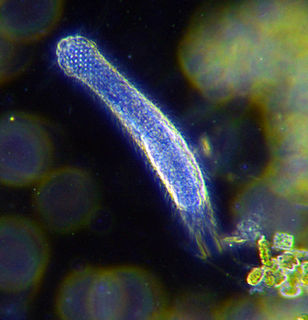
The gastrotrichs, commonly referred to as hairybellies or hairybacks, are a group of microscopic (0.06-3.0 mm), worm-like, pseudocoelomate animals, and are widely distributed and abundant in freshwater and marine environments. They are mostly benthic and live within the periphyton, the layer of tiny organisms and detritus that is found on the seabed and the beds of other water bodies. The majority live on and between particles of sediment or on other submerged surfaces, but a few species are terrestrial and live on land in the film of water surrounding grains of soil. Gastrotrichs are divided into two orders, the Macrodasyida which are marine, and the Chaetonotida, some of which are marine and some freshwater. Nearly 800 species of gastrotrich have been described.

Kinorhyncha is a phylum of small marine invertebrates that are widespread in mud or sand at all depths as part of the meiobenthos. They are also called mud dragons. Modern species are 1 mm or less, but Cambrian forms could reach 4 cm.

Sea cucumbers are echinoderms from the class Holothuroidea. They are marine animals with a leathery skin and an elongated body containing a single, branched gonad. Sea cucumbers are found on the sea floor worldwide. The number of holothurian species worldwide is about 1,717 with the greatest number being in the Asia Pacific region. Many of these are gathered for human consumption and some species are cultivated in aquaculture systems. The harvested product is variously referred to as trepang, namako, bêche-de-mer or balate. Sea cucumbers serve a useful role in the marine ecosystem as they help recycle nutrients, breaking down detritus and other organic matter after which bacteria can continue the degradation process.

Fish anatomy is the study of the form or morphology of fishes. It can be contrasted with fish physiology, which is the study of how the component parts of fish function together in the living fish. In practice, fish anatomy and fish physiology complement each other, the former dealing with the structure of a fish, its organs or component parts and how they are put together, such as might be observed on the dissecting table or under the microscope, and the latter dealing with how those components function together in living fish.
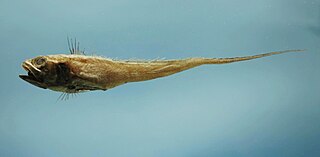
Macroudidae is a family of deep sea fish, a diverse and ecologically important group, which are part of the order of cod-like fish, the Gadiformes. The species in the Macrouridae are characterised by their large heads which normally have a single barbel on the chin, projecting snouts, and slender bodies that taper to whip-like tails, without an obvious caudal fin but what there is of the caudal fin is often confluent with the posterior dorsal and anal fins. There are normally two dorsal fins, the anterior dorsal fin is quite high, the posterior quite low but is longer and takes up a greater proportion of the fish's of the back, species in the subfamily Macrouroidinae have a single dorsal fin. The long anal fin is almost as long as the second dorsal fin is nearly as long as the posterior dorsal, and sometimes it is longer. The pelvic fin is inserted in the vicinity of the thorax and normally has 5-17 fin rays but are absent in Macrouroides. The body is covered in small scales and if they have a photophore, it is usually on the midline of the abdomen just in front of the anus. The bioluminescence of these fish is produced by symbiotic bioluminescent bacteria. The structure of the skull has been used to show their placing in the Gadiformes, but they differ from the typical cods in that they possess one stout spine in the anterior dorsal fin.

Ascidiacea, commonly known as the ascidians, tunicates, and sea squirts, is a polyphyletic class in the subphylum Tunicata of sac-like marine invertebrate filter feeders. Ascidians are characterized by a tough outer "tunic" made of a polysaccharide.
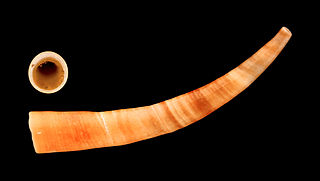
The tusk shells or tooth shells, technically the Scaphopoda, are members of a class of shelled marine mollusc with worldwide distribution, and are the only class of exclusively infaunal marine molluscs. Shells of species within this class range from about 0.5 to 15 cm in length. Members of the order Dentaliida tend to be significantly larger than those of the order Gadilida.
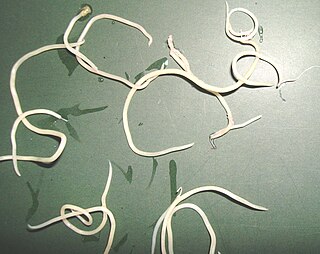
Ascaridia galli is a parasitic roundworm belonging to the phylum Nematoda. Nematodes of the genus Ascaridia are essentially intestinal parasites of birds. A. galli is the most prevalent and pathogenic species, especially in domestic fowl, Gallus domesticus. It causes ascaridiasis, a disease of poultry due to heavy worm infection, particularly in chickens and turkeys. It inhabits the small intestine, and can be occasionally seen in commercial eggs.
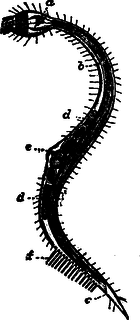
Chaetosomatida is a small group of minute, free-living, aquatic organisms which are usually placed as an annex to the Nematoda.

Haplodrili, or Archiannelida, is an order of primitive polychaete worms. Zoologist Ray Lankester gave it the name haplodrili, while zoologist Berthold Hatschek later named it Archiannelida. Once considered to be a class under Annelida, and even a separate phylum, Haplodrili is now widely accepted to be an order under Polychaeta. Species in this order are known for completely lacking external segments.

The blurred lanternshark is a little-known species of dogfish shark in the family Etmopteridae, found around the world in benthic and pelagic habitats from a depth of 110 m (360 ft) to over 1 km (0.62 mi) down. This shark forms the E. pusillus species group with the smooth lanternshark, which are distinguished from other members of its family by having irregularly arranged, flat-topped dermal denticles that give them a "smooth" appearance. Both species are slender-bodied with long heads, two dorsal fins bearing spines, no anal fins, and light-emitting photophores. The blurred lanternshark is larger, reaching 67 cm (26 in) or more in length. This species feeds on small squid, fishes, and fish eggs, and is ovoviviparous. It has been assessed as of Least Concern by the International Union for Conservation of Nature, because of its wide distribution and lack of threat from fishing pressure.

An earthworm is a terrestrial invertebrate that belongs to the phylum Annelida. They exhibit a tube-within-a-tube body plan, are externally segmented with corresponding internal segmentation, and usually have setae on all segments. They occur worldwide where soil, water, and temperature allow. Earthworms are commonly found in soil, eating a wide variety of organic matter. This organic matter includes plant matter, living protozoa, rotifers, nematodes, bacteria, fungi, and other microorganisms. An earthworm's digestive system runs the length of its body. It respires through its skin. It has a double transport system made of coelomic fluid that moves within the fluid-filled coelom and a simple, closed circulatory system. It has a central and peripheral nervous system. Its central nervous system consists of two ganglia above the mouth, one on either side, connected to a nerve running along its length to motor neurons and sensory cells in each segment. Large numbers of chemoreceptors concentrate near its mouth. Circumferential and longitudinal muscles edging each segment let the worm move. Similar sets of muscles line the gut, and their actions move digesting food toward the worm's anus.

The nematodes or roundworms constitute the phylum Nematoda, with plant-parasitic nematodes being known as eelworms. They are a diverse animal phylum inhabiting a broad range of environments. Taxonomically, they are classified along with insects and other moulting animals in the clade Ecdysozoa, and unlike flatworms, have tubular digestive systems with openings at both ends. Like tardigrades they have a reduced number of Hox genes, but as their sister phylum Nematomorpha has kept the ancestral protostome Hox genotype, it shows that the reduction has occurred within the nematode phylum.
This glossary describes the terms used in formal descriptions of spiders; where applicable these terms are used in describing other arachnids.

Eudistylia is a genus of marine polychaete worms. The type species is Eudistylia gigantea, now accepted as Eudistylia vancouveri. This worm lives in a parchment-like tube with a single opening from which a crown of tentacles projects when the worm is submerged. It is a sessile filter feeder. the Eudistylia Vancouveri is unique because it has an opiculum which makes it possible to fully retract into the tube when predators are sensed.
Eophasma is a genus of fossil nematodes from the Jurassic of Osteno in Lombardy, Italy. It has only one species, Eophasma jurasicum.

In zoology, a mesentery is a membrane inside the body cavity of an animal. The term identifies different structures in different phyla: in vertebrates it is a double fold of the peritoneum enclosing the intestines; in other organisms it forms complete or incomplete partitions of the body cavity, whether that is the coelom or, as in the Anthozoa, the gastrovascular cavity.
Leptopentacta elongata is a species of sea cucumber in the family Cucumariidae. It is found in the northeastern Atlantic Ocean and parts of the Mediterranean Sea. It is an infaunal species, occupying a burrow in the seabed, from which its anterior and posterior ends project.
Nectonema is a genus of marine horsehair worms first described by Addison E. Verrill in 1879. It is the only genus in the family Nectonematidae described by Henry B. Ward in 1892, in the order Nectonematoidea, and in the class Nectonematoida. The genus contains five species; all species have a parasitic larval stage inhabiting crustacean hosts and a free-living adult stage that swims in open water.
References
- ↑ Poinar Jr., George O. (2011). The Evolutionary History of Nematodes: As revealed in stone, amber and mummies. Nematology Monographs and Perspectives. 9. Brill Publishers. doi:10.1163/9789047428664. ISBN 9789047428664.
- ↑ WoRMS - World Register of Marine Species - Desmoscolecida
- Paolo Panceri, Atti dell'Accademia Pontaniana (previously, Atti della Società pontaniana di Napoli). vii. (1878)
- Richard Greeff, Archiv für Naturgeschichte 35 (i.) (1869), p. 112. (A. E. S.)
![]() This article incorporates text from a publication now in the public domain : Shipley, Arthur E. (1911). "Desmoscolecida". In Chisholm, Hugh (ed.). Encyclopædia Britannica . 8 (11th ed.). Cambridge University Press. p. 99.
This article incorporates text from a publication now in the public domain : Shipley, Arthur E. (1911). "Desmoscolecida". In Chisholm, Hugh (ed.). Encyclopædia Britannica . 8 (11th ed.). Cambridge University Press. p. 99.
| | This Chromadorea nematode (or roundworm-) related article is a stub. You can help Wikipedia by expanding it. |